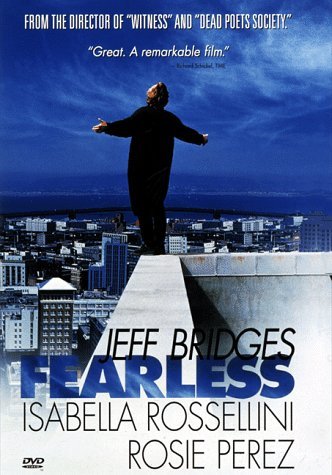No Cure: The Fearless Misdiagnosis
After viewing a Discovery Health special called “The Man Who Slept for 19 Years,” I can now confidently state that in Fearless (1993), (a movie all should see recently reissued on DVD) Post-traumatic Stress Disorder, PTSD, is a major misdiagnosis of Max Klein’s condition. In the film, Jeff Bridges plays Max Klein, a San Francisco architect who walks away from an airliner crash unharmed. He walks away a changed man, almost the opposite of who he was before the crash. Suddenly he’s fearless. At the time of production in the early 90’s such personality shifts were explained by psychiatrists, who would diagnose PTSD. But in “The Man Who Slept for 19 Years,” Discovery Health reports doctors studying the coma are finding that such personality shifts are far more likely due to microscopic temporal lobe damage sustained when the brain rocks forward in the skull upon impact (such as a plane crash) causing a collision within the skull between the temporal lobe at the front of the brain and the rough, almost jagged interior forehead region of the inner skull.
The inside of the human forehead is brittle to the touch and sharply contoured. When you are impacted in the forehead, the front of your brain (temporal lobe) smashes into the skull and can cause brain damage. Coma studies thus far seem to show the temporal lobe is the seat of the personality, where the brain regulates our personal attachments, opinions and tastes. Even microscopic tears at the right spots in this area can permanently alter the personality. Certain key emotions, such as fear, can be seemingly turned off in the person afterward, as is the case with the fictional Max Klein. The misdiagnosis of Max (which the film is aware of) is a case of Psychology’s failure to acknowledge Biology. Biology will almost always cancel out Psychology because emotions have a physical basis, in the brain. Our essence is not spiritual, but physical. Your brain is your soul, and in a split second your soul can completely change. Efforts to reverse engineer the coma have brought doctors to this biologically-deterministic conclusion.
To clarify, according to my reinterpretation Max Klein is suffering not from PTSD, but from a minor brain injury sustained when he hit his head in the plane crash. Due to its physical and not psychological nature, Max’s injury is not treatable through psychotherapy. Nor is it treatable through surgery because the brain is still too much of a mystery to know how to repair such damage. Therefore Max’s condition is untreatable and irreversible. His troubling fearlessness is actually a kind of coma.
Fearless is propelled by powerful scenes of Max playing with death. Bridges’ portrayal of Max is captivating. We are encouraged to admire Max’s fearlessness, his mysterious detachment from all personal matters, his brutal honesty about himself and his feelings toward his family. Unfortunately the movie tries to make sure all those powerful scenes get canceled out. 2/3rds through we’re ready to calmly step out onto a thousand foot tightrope with a smile. Fearless finds itself sending a dangerous message, and sending it in a powerful way:
You are missing out. Your cringing life of cowardice is
pathetic. Break the chains of your fear. Stand out on that
ledge and confront God as an equal. This is the only way
you can really feel like you’re alive.
That’s the message. Fearless is not comfortable sending that message. Before the end it must switch and become a conformity-enforcement tool before we find ourselves a country of suicidal rejoicers. Fearless goes conformity by siding with the wife. As we’re watching along, the more we admire Max for his alien lack of fear or inhibition, the more we begin to see through his wife (Isabella Rosselini), whose desperate measures to save the family appear more and more petty and selfish. We cringe as she resorts to using her son as a blackmail device. She’s pretty sad, and we begin to sympathize with Max’s indifferent attitude toward her.
She has no business winning, but she leads the conformity-enforcement charge to victory over Max anyway following the corporate entertainment precept which states: “It’s important to bring edgy stories to bogus conclusions.” At the end Max changes, not the wife. He is in the wrong. He succumbs to her. I wont’t tell you exactly what happens but I can tell you it’s a cheap ending, a bad ending. But there’s good news. My new diagnosis of Max’s condition makes any such ending impossible. Now we can walk away from it enjoying the film but knowing it is flawed, knowing Max did not return to his family and a life of domesticated fear (a return to cowardice), as the revival at the very end could imply. On the contrary we know as long as he is alive Max is going to remain just as we liked him—reckless, irresponsible, honest— because there is no cure, either medical or psychiatrical, for his inoperable brain injury.

